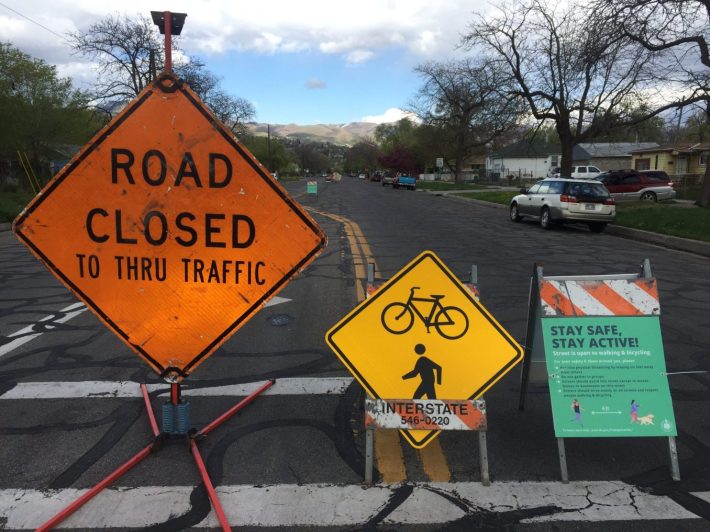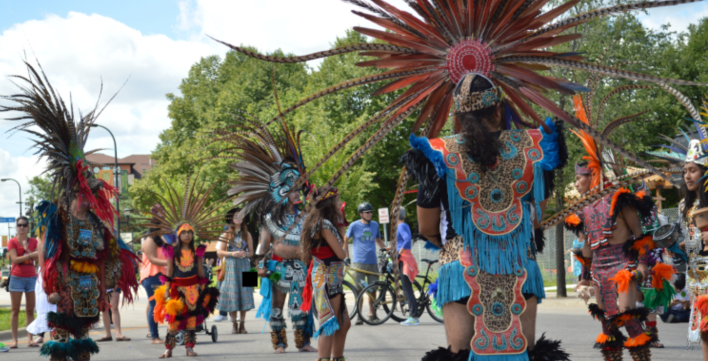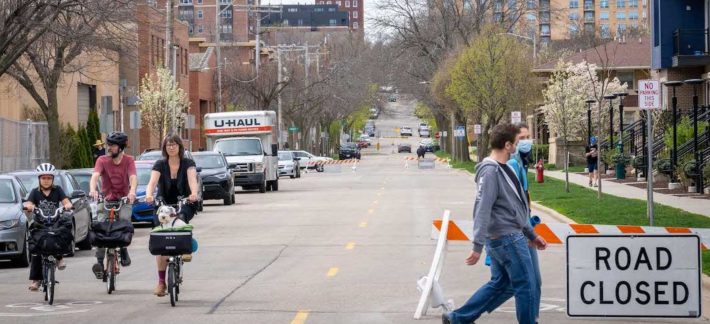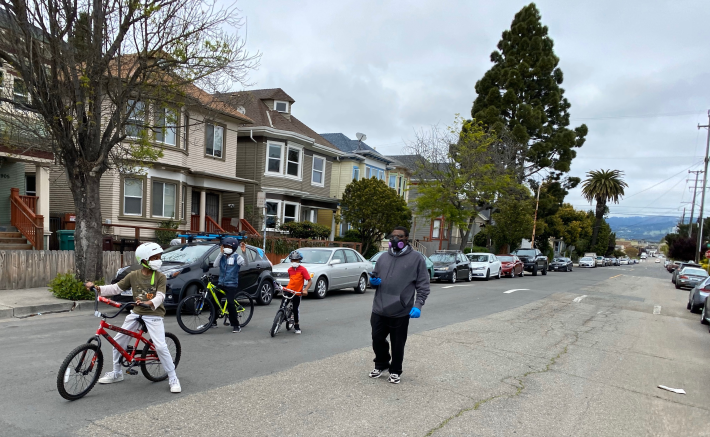Update 5/9/20, 12 PM: Yesterday the city of Milwaukee and Milwaukee County officials announced an Active Streets plan to ban or restrict motor vehicle traffic on ten miles of streets in the region. Congratulations to the Wisconsin Bike Federation on helping to make this happen.
Pretty much ever since Illinois' Stay at Home order went into effect, Streetsblog Chicago has been advocating for opening streets for safe, socially-distanced walking and biking. In contrast, the Active Transportation Alliance initially argued that "The context of a pandemic does not seem like the most appropriate moment to be pushing forward this vision.”
However, apparently thanks in part to our advocacy, along with feedback ATA received from members, and the fact that most politically progressive big U.S. cities are currently doing open streets interventions, this week the advocacy group revealed that its position has evolved. They're currently in talks with local leaders about strategies to prevent a post-pandemic spike in driving, such as Oakland-style Slow Streets; temporarily widening sidewalks in busy retail corridors; and creating emergency bike lanes. Streetsblog applauds ATA's change in strategy.
To get a better sense of how the open streets conversation has been playing out in other cities across the United States, I reached out to many of ATA's peer organizations and got responses from Oakland, Seattle, Salt Lake City, Denver, Minneapolis, Philadelphia and Madison, Wisconsin. The majority of them said they were in favor of the open streets / Slow Streets concept, in which where streets are opened to pedestrians and cyclists, in which car traffic is restricted or banned completely. They felt that this would facilitate social distancing and reduce crashes, and many pointed to the potential benefits for residents' physical and mental health.
However, Our Streets Minneapolis told me they're not advocating for open streets during COVID-19. They cited similar reservations as the ones ATA originally expressed, arguing that programs to improve walking and biking during the pandemic should be a lower priority than efforts to keep transit safe for essential workers and operators. They also argued that it would be difficult to get meaningful public input, especially from marginalized communities, with lockdown orders in place.

Why open streets
A common theme among the organization supporting open streets is that they were responding to what they were seeing on the ground: high demand for trails that sometimes made social distancing difficult.
Caressa Givens, the Milwaukee project manager at Wisconsin Bike Federation, said that's why they prioritized putting opening streets in Milwaukee and Madison. “We were seeing exponentially high trail counts,” she said. “In the city of Milwaukee, our combined trail counts from this time, in March, had grown, collectively, almost 90 percent.”
Crys Lee, executive director of Bike Utah, said that they saw clear evidence in Salt Lake City that the usual transportation paradigm wasn’t working well during the pandemic. “Over the past several weeks traffic has decreased significantly and we have several multi-lane roads that are now being underutilized while sidewalks are being overrun,” she said via email. “We believe that borrowing the unused lanes and creating protected open areas that extend the sidewalks and expand the bicycle lanes help to meet the current needs of our community.”
“There are sidewalks [in Oakland] that are six feet wide or less,” said Dave Campbell, the advocacy director at Bike East Bay. “And we saw that people were walking on the street, or walking their dogs on the street, just to avoid [each other].”
Another common theme was that drivers who are still on the road are becoming more reckless.
“We believe that open streets and Slow Streets can be used as a tool to keep people safer,” said Randy LoBasso, the policy manager at the Bicycle Coalition of Greater Philadelphia. “We're seeing a lot fewer vehicles on the road, but the vehicles that we do see are people driving much faster than usual, so we're actually seeing an uptick of pedestrian deaths in Philadelphia.”
In many instances, open streets efforts were further spurred by cities’ decisions to close parks. In Chicago, Mayor Lori Lightfoot closed the entire lakefront, the Chicago Riverwalk, and the Bloomingdale Trail, but left most of inland parks open. Meanwhile, Cook County president Toni Preckwinkle closed the parking lots of several popular forest preserves near Chicago in order to discourage large crowds but didn't close the preserves themselves.
In Oakland, the regulations have been stricter. “Our city parks are closed, and our regional parks are restricting access, so people couldn't get there unless they biked or walked there,” Campbell said, adding that Bike East Bay wanted to use Slow Streets to make it safer for residents to get to those regional parks.
In Philadelphia, most parks are open, but LoBasso said during the pandemic there have been crowding issues on weekends. He said opening streets for walking and biking seemed like a good way to provide recreational opportunities while allowing residents to practice social distancing. “We’re saying don't congregate in parks, so where do we want people to go? If we give people more space, they will maintain six feet of space from one another.”
Many of the organizations also feel open streets is good for promoting wellness during this stressful time. Molly McKinley, the grassroots advocacy manager at Bicycle Colorado, said that this is why her organization lobbied the city of Denver to open up some streets after the lockdown measures went into effect. “Having spaces to bike and run is good for physical and mental health, and just to build community,” she said. “And the hallmark of being in Colorado is being outside. Being active is who we are in general.”
“This is not necessarily a bike issue, this is a public health issue,” Wisconsin Bike Fed's Givens said. “We want to make sure [can] get outside and move, and make successful trips. There might be people who'd use the trail system to get to work”
And in Seattle, the Cascade Bicycle Club says open streets is all about safety. “I think I think it has really shown there are limitations in the existing infrastructure,” said Vicky Clarke, the organization’s policy director. “Everyone has a right to walk and bike safety, and having the network of those open streets is ideal.” Today Seattle announced plans to permanently open 20 miles of "Healthy Streets."

Dissent and downsides
Ashwat Narayanan, executive director of Our Streets Minneapolis, emphasized that his organization has nothing against open streets per se – they just don’t believe it should be their focus right now. “One, we want to prioritize transportation needs, and it seems like a lot of open streets advocacy has been focusing on recreational needs,” he said, adding that they want to ensure transit workers and essential employees in general have access to personal protective equipment.
Generally, Narayanan said, they are wary of trying to push for any infrastructure changes without getting community input – especially in communities of color. “We want to understand their transportation advocacy goals that are not being heard,” he said, adding that COVID-19 makes that kind of outreach difficult.
Narayanan added Our Streets already cancelled their usual planned Open Streets event in June. They will be making decisions about whether to cancel the remaining events later this year on case-by-case basis, at least eight weeks ahead of the time.
Bike East Bay's Campbell said that while most Oakland residents seem to like the Slow Streets program “There's four [streets], I would say, where some community members are not happy, they feel like it's something they haven't asked for.” He acknowledged that what may work for some residents may not work for others, and while BEB would like to talk to those residents and try to address their grievances, the shelter-in-place order makes it “not impossible, but difficult.... It's been a challenge. We haven't heard from enough [people] to have a sense of what are the issues, what are the concerns.”
Campbell added that he has gotten feedback from some people who feel there are other issues that deserve more attention, such as making sure homeless people are given the opportunity to stay in hotels where they can social distance safely.
Wisconsin Bike Fed's Givens said her organization reached out to the community to “ease some... misconceptions and concerns,” emphasizing that they wouldn’t be closing crowded streets, and that on Slow Streets, residents would still be able to drive in and out, and emergency vehicles would still be able to pass through. One thing the bike federation wanted to get across was that “it’s not about bicycles versus cars.”

How it has worked in practice
The experiences of the different cities have varied. Campbell said Bike East Bay originally wanted to see more measures – such as having all traffic lights flash red to discourage drivers from speeding through interactions – but the city of Oakland declined. But the city ultimately agreed to designate 74 miles of neighborhood streets as slow streets. “The reason why the city proposed so many miles is that they wanted to have it in all neighborhoods in the city,” Campbell said. “They wanted to keep it... fair.”
Campbell added that Oakland specifically took cues from Denver. Bicycle Colorado's McKinley said that, as of last Friday, Denver has opened about five miles of [Slow Streets], and ten miles of open streets.” Since she lives near one of them, she gets to experience the benefits firsthand on a regular basis. “It's kind of a highlight on my day, to go for a run and a bike ride, and being able to see more of my neighbors every day -- just not being [physically] close to them.”
Wisconsin Bike Federation's Givens said that while Madison's city government got on board fairly quickly -- something that she credited to the city’s active and engaged cycling community -- Milwaukee has been slower going. She attributed that to the fact that the 2020 election saw some turnover in the city and county governments. Givens was quick to emphasize that both the city of Milwaukee and the Milwaukee County transportation departments supported the concept, and she believes that Slow Streets will ultimately get approved there, too.

The city of Philadelphia agreed early on to close a portion of Martin Luther King Drive, which links northeast Philly to the Center City downtown area. While LoBasso said it was a welcome step forward, his organization has been lobbying to open more streets for walking and biking .
Cascade Bicycle Club's Clarke explained that Seattle is taking a somewhat different approach, focusing their efforts on greenways. “They started with two miles and they have been adding [to] it,” she said. The approach has limits, since greenways don’t extend into all areas. But Clarke gave the city credit for trying to address structural inequities. “I think they tried to prioritize communities that have less access to open space, and whether it has higher density,” she said. “And I think there's a correlation between the communities of color and communities that have low access to open space.”
Bike Utah is a pushing to turn traffic lanes into temporary bike lanes and pedestrian spaces, Lee said. At the moment, they are focusing their lobbying on Salt Lake City, while also encouraging the Utah Department of Transportation to implement the concept in other cities. “We believe that borrowing the unused lanes and creating protected open areas that extend the sidewalks and expand the bicycle lanes help to meet the current needs of our community."

Looking to the Future
Of the advocacy organizations that responded, Bike Utah has taken a relatively cautious approach. Lee shared a memo that emphasized several times that the measures were temporary. However, she said hopes that seeing open streets in action will give local and state governments new appreciation for the importance of outdoor spaces and facilities.
Other organizations hope for longer-term impact. “In Denver, I think there are opportunities to keep the open and shared streets in place even after the physical distancing requirement has lapsed,” McKinley said.
Cascade Bicycle Club's Clarke said that, judging from surveys her organization conducted, there has been a growing interest in cycling during the pandemic. But, at the same time, they have noticed the car traffic creeping back up. “If we're not proactive, I think we're going to see our community soaked in congestion. Open street is a great first step, but as people start to go back to their jobs more, and going back to traffic patterns, we need a bike networks implemented faster, not slower. No piece of our life is going to go back to business as usual after this pandemic, and how we think about our streets and we get around has to be a piece of that.”
Some of these organizations are already laying the groundwork for the future. “We intend to create a much more substantial plan, and not [just] for now, [but for] a month from now, and for what we believe to be a post-COVID reality, since there are are likely to be fewer vehicles at that point,” The Bicycle Coalition of Greater Philadelphia's LoBasso said. “And once the economy does reopen, making sure that not everybody gets into the vehicle and causes worse congestion than it was before. We've seen some cities in China reopen and people retreating back to their motor vehicles. We want to give people some options, [so they don't have to] get back into the motor vehicle.”





